When you’re out in the wilderness, one tool can often make the difference between a successful excursion and a survival situation is a good, reliable knife.
Now, not just any knife, but a handmade Damascus bushcraft knife with a leather sheath — a tool that combines craftsmanship and functionality in a single, elegant package.
The Damascus bushcraft knife stands as a testament to this ethos. It’s not merely an object, but a reliable tool that shares in your journey, assists in your tasks, and ultimately, enhances your bushcraft experience.
How, you ask? Read on and let’s delve into the world of this exceptional tool, and explore what makes it indispensable to your bushcraft gear.
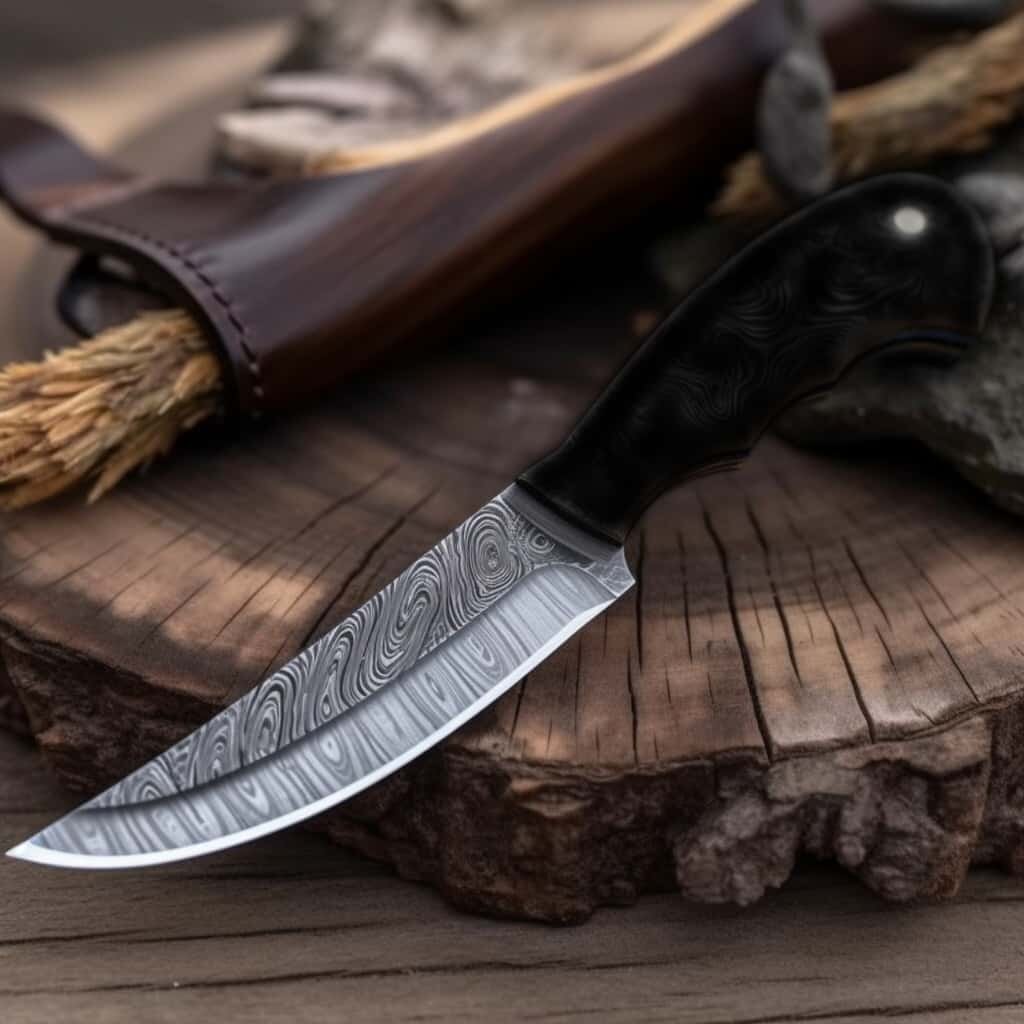
In This Guide
Blade Material: 288 layers of Damascus steel
Blade Length: 4.8 inches
Weight: 8.2 oz
- High-quality Damascus steel
- Beautiful walnut handle
- Includes leather sheath
- Suitable for various outdoor tasks
- Sheath quality could be better
- May require frequent sharpening
One of the standout features of this knife is its comfortable and ergonomically designed walnut wood handle, designed to handle any task with ease. And at just 8.2 ounces, this knife feels substantial without being burdensome.
Taking it with you is a breeze thanks to the genuine leather sheath with an EDC belt loop and snap fastener, making it highly portable for all your outdoor excursions.
What Is A Damascus Knife?
A Damascus knife is a type of knife made from Damascus steel, a type of steel known for its distinctive wavy or swirling patterns and durability, making it a popular material for knife blades.
Damascus steel is created by repeatedly folding and welding different types of steel together, then subjecting the material to acid etching.
This process results in alternating layers of hard and soft steel, leading to the characteristic patterns seen on the blade, akin to flowing water or a landscape.
There are many sheets of steel that are great for bushcraft, however, Damascus steel holds its own as a reliable option.
The combination of hard and soft steel in the blade gives Damascus knives a sharp edge and a degree of flexibility, making them highly prized among chefs, hunters, and knife enthusiasts.
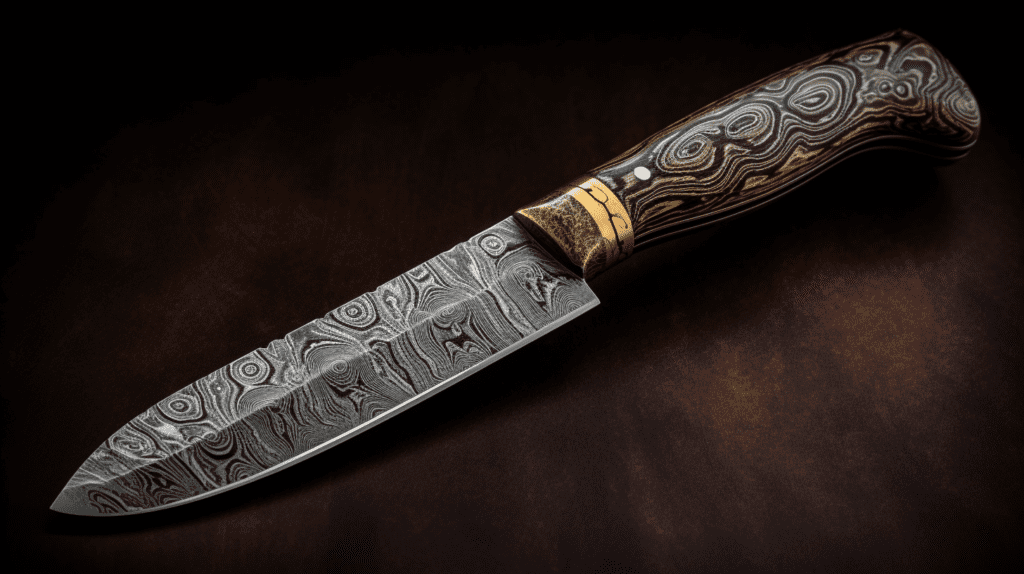
Damascus Bushcraft Knife Overview
The Damascus bushcraft knife is an exquisite blend of aesthetics and functionality, creating an exceptional tool for outdoor enthusiasts.
Its distinguishing features lie in its unique blade and meticulous crafting process, which makes it a standout in the realm of bushcraft.
Blade
The unique characteristic of Damascus steel is its stunning patterned surface, resembling flowing water or a unique landscape.
This pattern is not merely decorative; it signifies the layered combination of different steels, resulting in a tough, sharp blade that’s well suited to the rigors of outdoor use.
Type of Steel
When choosing a bushcraft knife, materials matter. Damascus knives are crafted from a blend of 1095 high carbon steel and 15N20 steel, giving you a strong and durable tool.
The mixture of these two elements provides the foundation for a high-performing knife.
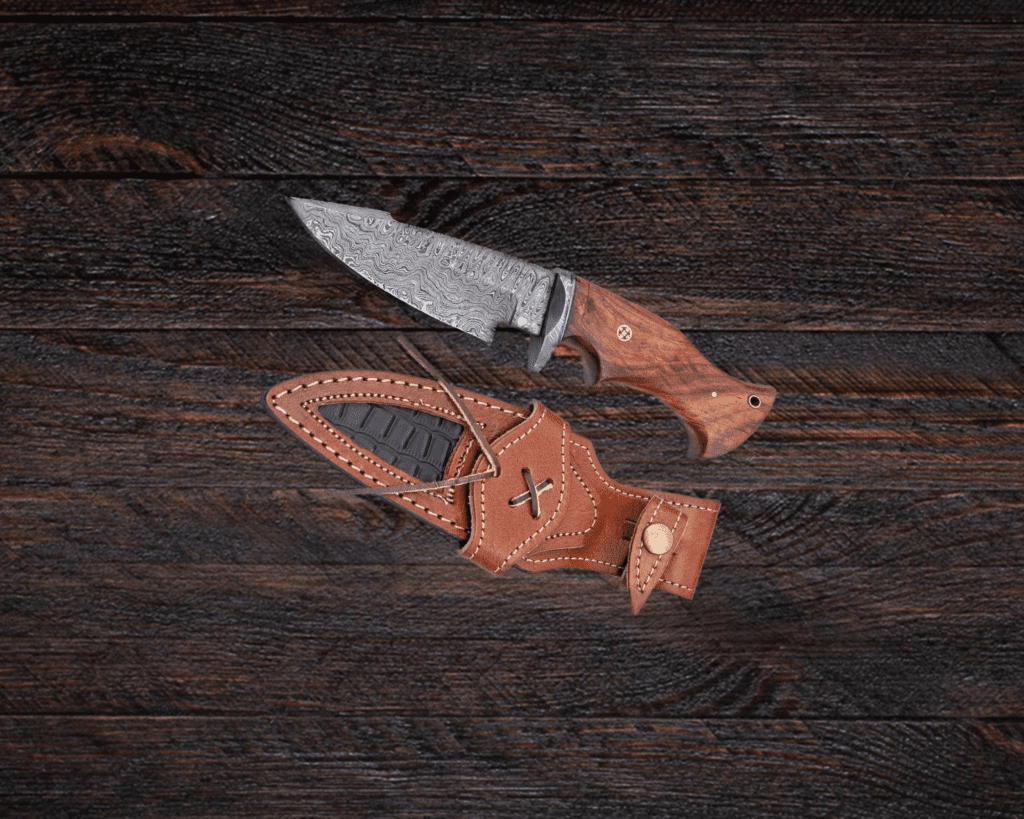
Craft
The art of forging Damascus blades involves folding and heating the metals multiple times to achieve unique patterns and high hardness.
This process results in a blade with an impressive 56-58 HRC, meaning your knife will have a beautiful appearance and hold its sharp edge for a long time.
Superior Sharpness
With Damascus bushcraft knives, you can expect razor-sharp edges right out of the box.
The unique combination of steel yields an exceptionally sharp blade perfect for various bushcraft tasks.
Life-Long Sturdiness
You want a knife that won’t let you down, and a Damascus bushcraft knife offers life-long sturdiness.
Due to the unique forging process and high-quality materials used, these knives can withstand the rigors of outdoor activities and maintain their toughness and durability for years to come.
Use
Damascus bushcraft knives are highly versatile, capable of handling a wide range of tasks in the wilderness.
Despite their aesthetic appeal, these knives are designed for practicality and effectiveness, capturing the essence of bushcraft.
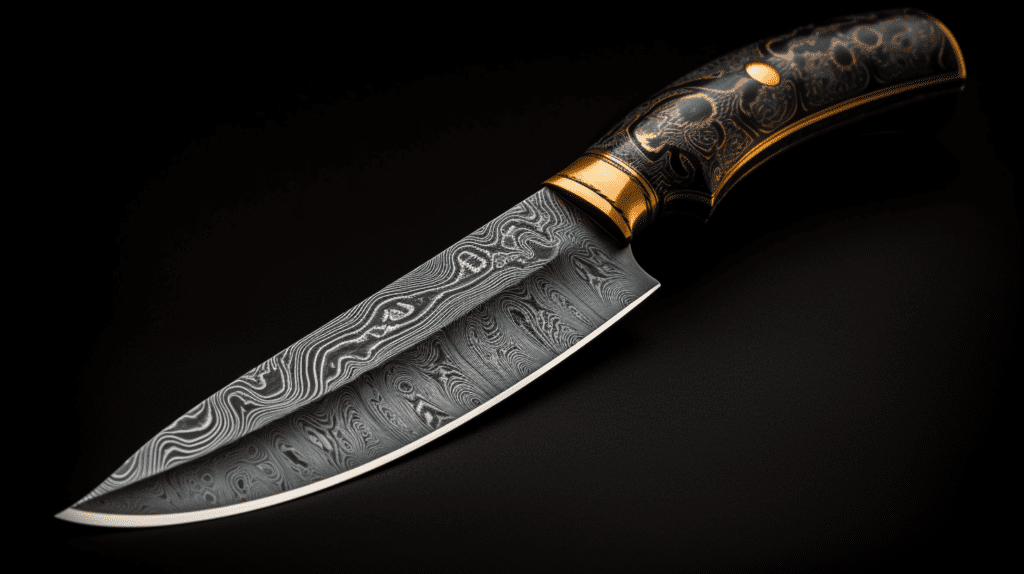
Essential Features Of A Damascus Knife
Full-Tang Design
Full tang means the blade and handle are made from one continuous piece of steel.
You’ll notie that a full-tang Damascus steel blade offers strength and balance. This feature will ensure your knife can withstand the rigors of outdoor tasks.
Handle Material
Selecting a handle material is essential for both aesthetics and functionality.
A common choice for a Damascus bushcraft knife is a buffalo horn handle. It’s not only visually appealing but also provides a comfortable and secure grip during use.
Blade Length
When it comes to blade length, a 5-inch blade is an ideal size for a Damascus bushcraft knife.
It’s long enough to handle various tasks such as making kindling, carving, and batoning wood while remaining compact.
Meticulously Constructed Handle
Invest in a knife with a meticulously constructed handle. This ensures that it feels comfortable in your hand, allowing you to use the knife for extended periods without fatigue.
A well-crafted handle enhances control, to make precise tasks easier to control.
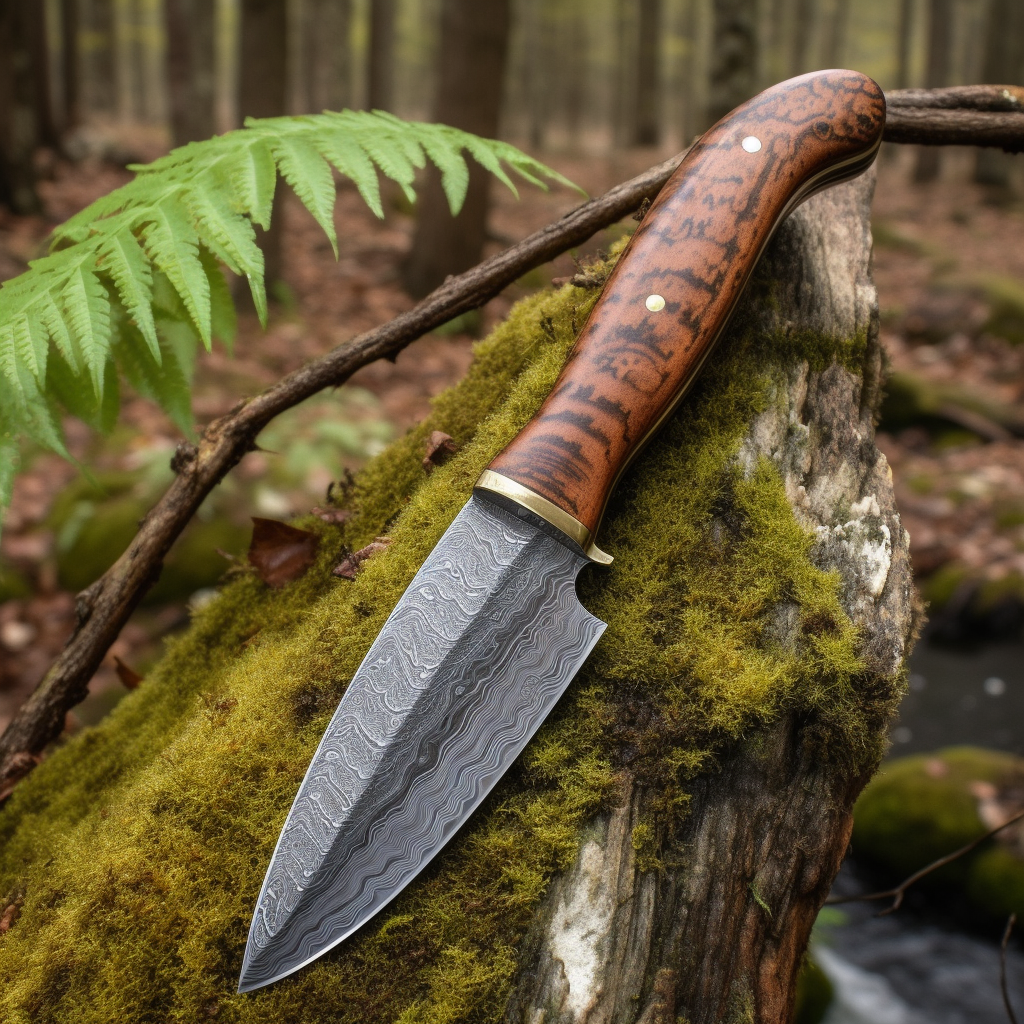
The Damascus Knife And Its Unique Aesthetics
Bone Handle
A bone handle on a Damascus bushcraft knife adds a classic touch to its overall design.
Bone is a durable, long-lasting material that provides a comfortable grip. Each bone handle has its distinct appearance, making your knife a one-of-a-kind piece.
Mirror Polish
A mirror polish on your Damascus bushcraft knife not only enhances its beauty but also provides practical benefits.
The high level of polish helps reduce friction during cutting, making the knife easier to use.
A mirror-polished knife is easier to clean and maintain, ensuring it stays in top condition for longer.
Different Types of Damascus Knives
Damascus Hunting Knife
Damascus hunting knives are a popular choice for outdoor enthusiasts. They’re perfect for tasks like skinning, gutting, and deboning game due to their durability.
Tactical Knife
For more tactical purposes, a Damascus tactical knife is an excellent option. These knives feature a robust, full-tang design for resilience in tough situations.
Damascus Steel Production and Special Treatment
Hand-Forged Damascus Steel
Damascus steel is produced through a forging process where several irons and metals are cast together by hammering them at high temperatures.
This process creates the patterns on the steel and enhances its durability. As a result, you get a sturdy and visually appealing bushcraft knife.

Rockwell Scale
The performance of your Damascus bushcraft knife is also influenced by its Rockwell hardness (HRC).
A perfect balance of hardness and toughness ensures a long-lasting and functional blade.
Take note of the HRC rating when selecting a knife, as it indicates the steel’s resistance to wear and deformation.
How To Maintain Your Damascus Knife
Maintaining a Damascus knife requires a bit more care compared to standard stainless steel blades due to the unique properties of its steel.
Here’s a simple guide to keep your knife in top shape:
Regular Cleaning
Always clean your knife after use, especially if it has been in contact with moisture or acidic substances. Use warm soapy water and a soft cloth or sponge. Never use harsh cleaning agents or scrubbers, as they can damage the blade’s finish.
Dry Thoroughly
Damascus steel can rust if left wet. After cleaning, dry your knife thoroughly with a soft cloth. Make sure to get into all the nooks and crannies.
Oil Your Knife
To protect the steel and bring out the contrast in the pattern, regularly oil your Damascus knife. Use mineral oil or a special knife oil. Apply a small amount to a soft cloth and gently rub it into the blade.
Sharpening
Over time, your knife may lose its sharpness. It’s essential to sharpen your Damascus knife correctly. It’s best to use a whetstone. Always maintain the same angle (usually around 20 degrees) when drawing the blade across the stone.
Proper Storage
When not in use, store your knife in a dry, safe place. The leather sheath it comes with is ideal for storage. Avoid storing your knife in overly humid areas or places with significant temperature changes, as this can promote rusting.
Periodic Inspection
Regularly inspect your knife for any signs of rust or other damage. If you notice small rust spots, you can remove them using a bit of oil and a soft cloth. For more severe rusting, you may need to seek the help of a professional.
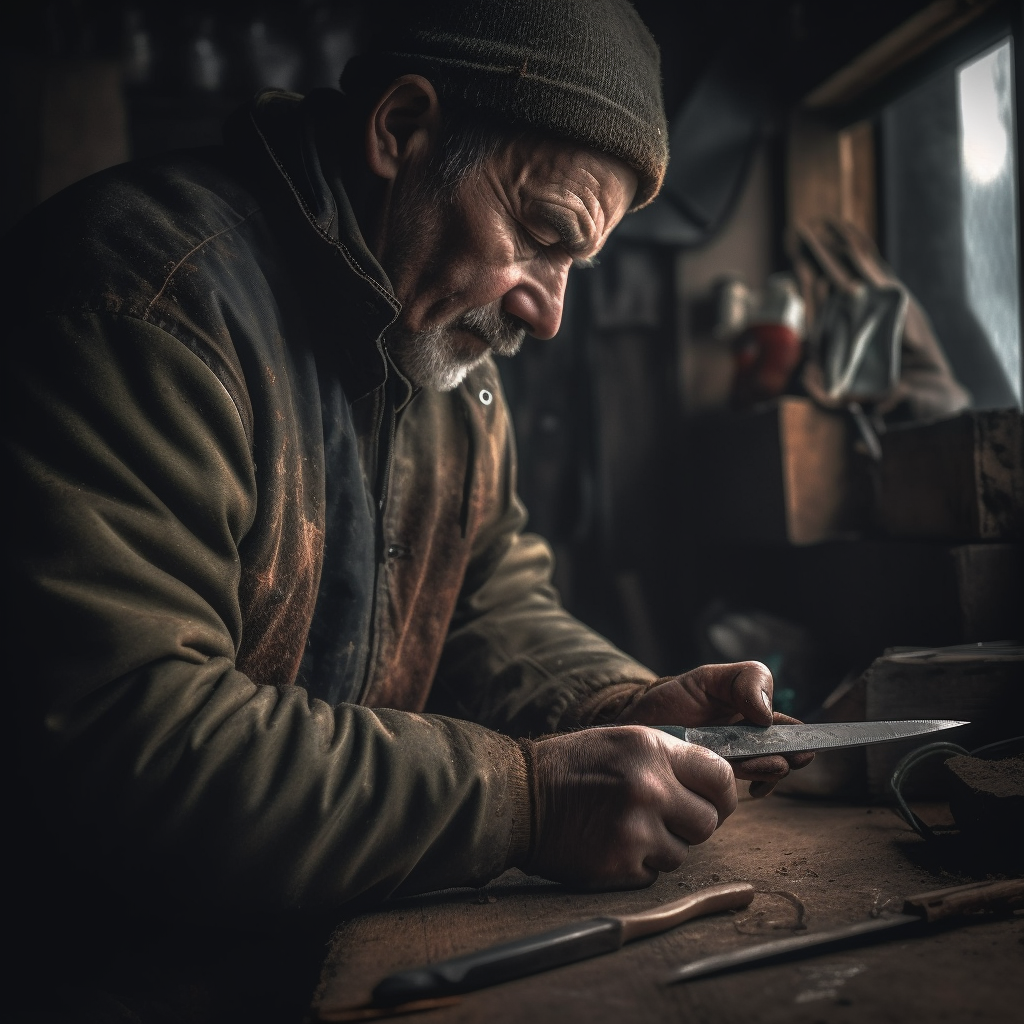
Leather Sheath For Your Damascus Knife
A leather sheath for a Damascus knife provides a secure and protective housing for the blade, preserving its sharpness and preventing accidental damage or injury.
One aspect to consider is the thickness of the leather used in the sheath. Generally, thicker leather provides better protection for your knife, but it might be stiffer and heavier.
A balance of protection, flexibility, and weight is crucial for outdoor activities.
Caring For Your Leather Sheath
Here’s a brief guide to understanding and caring for your leather sheath:
Cleaning
Over time, your leather sheath may accumulate dirt or grime. When cleaning, avoid soaking it in water as this can make the leather brittle. Instead, use a damp cloth and a gentle leather cleaner.
Conditioning
To maintain its flexibility and prevent cracks, condition your sheath regularly with a quality leather conditioner. This will also help to preserve its color and finish.
Storage
Avoid storing your sheath in damp or excessively dry environments, as both can damage the leather over time. Store it in a cool, dry place.
Protection
If you’re in wet conditions, consider applying a waterproofing treatment to your sheath to protect it from moisture damage.
Remember, your Damascus knife and its leather sheath are partners. By taking care of both, you can ensure they continue to serve you well on your bushcraft and survival adventures.
Age Recommendation
When considering a Damascus bushcraft knife, you should know the recommended age for safe handling.
Due to its sharp blade and high hardness, it’s advised that users be at least 18 years of age. Of course, this doesn’t mean younger individuals can’t learn to use a bushcraft knife responsibly.
As a responsible adult guiding someone younger, you must take all necessary precautions. Teach them safety measures and proper techniques before they get hands-on experience.
Remember, knife skills come with time and practice, no matter your age.
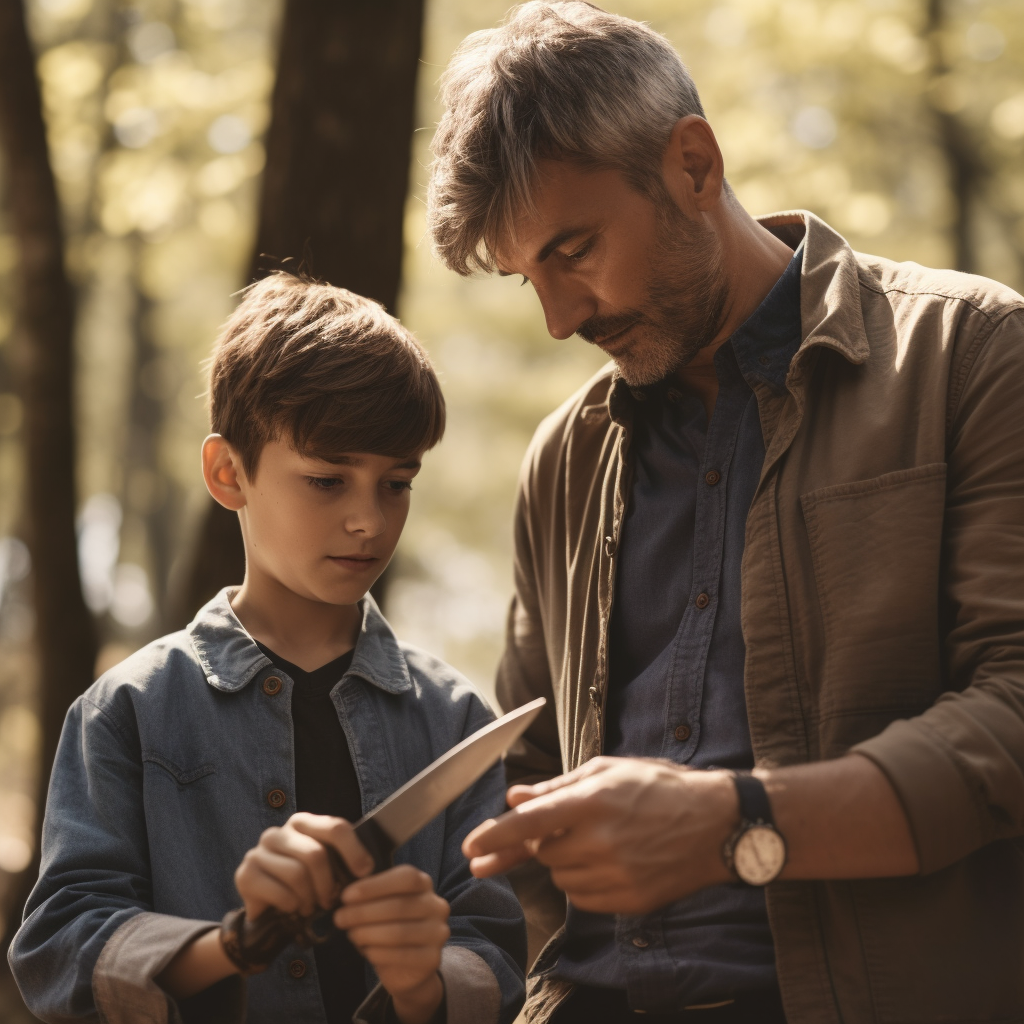
FAQs
Why choose a Damascus bushcraft knife?
These knives offer great durability and edge retention, making them suitable for various outdoor tasks such as hunting, carving, and wood processing.
Are Damascus bushcraft knives handmade?
Yes, Damascus knives are generally handmade, ensuring a high level of quality and attention to detail.
Is Damascus steel suitable for all bushcraft tasks?
As long as your knife is made from high-quality steel and has a proper forging process, it will be excellent for various bushcraft tasks.
However, always choose a knife with features that meet your specific needs.
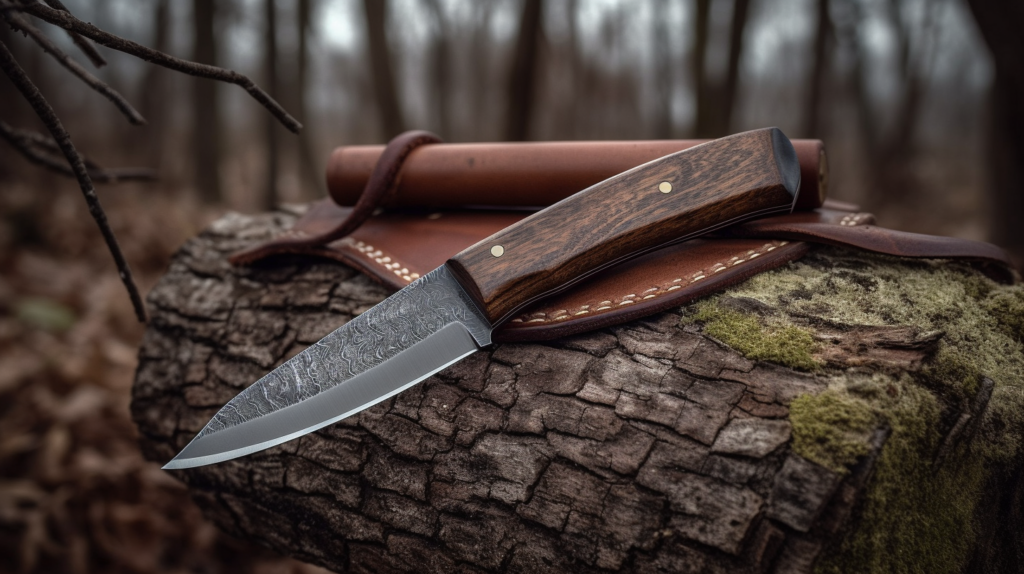
Handmade Damascus Bushcraft Knife: Key Takeaways
The Damascus bushcraft knife is more than just a tool — it’s a work of art, a historical symbol, and a reliable companion in the wilderness.
Its exquisite design, unparalleled durability, and exceptional performance make it a standout piece in any collection.
By maintaining it correctly and treating it with the respect it deserves, you can ensure that this remarkable blade serves you well for years to come.
Own it, use it, care for it, and it becomes more than just a knife — it becomes a part of your preparedness journey.
ABOUT THE AUTHOR
Bill Montgomery is the co-founder of Modern Day Prepping. He and his wife Angie have been dedicated to the self-reliant lifestyle since 2008. When he’s not working on the homestead, he enjoys tinkering with electronics and family movie nights with Angie and their two boys. To learn more about Bill, visit the About Us page.
If you want to know how to keep your family safe in the modern world, visit Privacy For Patriots, a sister site that Bill started to help fellow Patriots stay "off the radar" from bad actors and big tech.



0 Comments